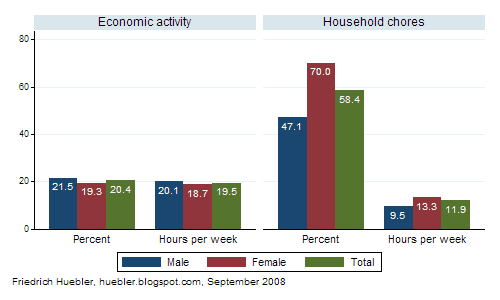One limitation of statistics like those published by the ILO is that they only refer to economic activity, that is work related to the production of goods and services, as defined in the United Nations System of National Accounts (UNSD 2001). This definition excludes chores undertaken in a person's own household like cooking, cleaning or caring for children.
Statistics of child labor that ignore household chores are problematic because they underestimate the burden of work on children, especially for girls. To examine the relative burden of economic activities and household chores carried out by children, data from 35 household surveys were analyzed for this article. Grouped by Millennium Development Region, these surveys are:
- Developed countries: Albania.
- Eastern Asia: Mongolia.
- South-eastern Asia: Lao PDR, Philippines.
- Southern Asia: India.
- Western Asia: Bahrain, Lebanon, Palestinians in Syria.
- Sub-Saharan Africa: Angola, Burundi, Central African Republic, Chad, Comoros, Congo, Côte d'Ivoire, Democratic Republic of the Congo, Gambia, Guinea, Guinea-Bissau, Kenya, Lesotho, Malawi, Mali, Niger, Senegal, Sierra Leone, Somalia, Swaziland, Tanzania, Uganda.
- Latin America and the Caribbean: Bolivia, Colombia, Dominican Republic, Nicaragua, Trinidad and Tobago.
The share of children aged 7 to 14 years in economic activity and household chores is depicted in the following graph. The graph also displays the number of hours spent per week on both types of work. All numbers are averages across the 35 surveys, weighted by each country's population between 7 and 14 years.
Economic activity and household chores, children 7-14 years

Data source: 35 DHS and MICS surveys, 1999-2005.
The results confirm that boys are more likely to be engaged in economic activity while girls are more likely to do household chores. On average across the 35 surveys, 22 percent of all boys and 19 percent of all girls between 7 and 14 years are engaged in economic activity. Boys also spend more hours on economic activity than girls, 20 compared to 19 hours. By comparison, girls are much more likely than boys to do household chores. 70 percent of all girls and 47 percent of all boys did household chores in the week preceding the survey. On average, girls spent 13 hours and boys 10 hours per week on household chores.
What are the implications of these findings for statistics of child labor, as currently defined by the ILO? Take the case of two families that need additional income to provide food for everyone in the household. In the first family, a 10-year-old boy is withdrawn from school and put to work on a farm. Because such work is considered economic activity the number of child laborers goes up. In the second family, the mother decides to start working on a farm and her 10-year-old daughter is asked to stay at home to care for her younger siblings. Because the girl is engaged in household chores the number of child laborers does not change. The consequences are the same for both children: they no longer go to school and miss out on the benefits from education.
To address the limitations of the ILO's definition of child labor, UNICEF has developed an expanded definition that covers household chores in addition to economic activity. This revised indicator is the basis for the child labor estimates that are reported in publications like Progress for Children (UNICEF 2007a) or The State of the World’s Children (UNICEF 2007b). For children 5 to 17 years of age, UNICEF defines child labor as follows:
- 5 to 11 years: any economic activity, or 28 hours or more household chores per week;
- 12 to 14 years: any economic activity (except light work for less than 14 hours per week), or 28 hours or more household chores per week;
- 15 to 17 years: any hazardous work, including any work for 43 hours or more per week.
References
- International Labour Organization (ILO). 2006. Global child labour trends 2000-2004. Geneva: ILO. (Download PDF, 640 KB)
- United Nations Children's Fund (UNICEF). 2007a. Progress for children: A World Fit for Children statistical review. New York: UNICEF. (Download PDF, 3.6 MB)
- United Nations Children's Fund (UNICEF). 2007b. The state of the world's children 2008: Child survival. New York: UNICEF. (Download PDF, 4.3 MB)
- United Nations Statistics Division (UNSD). 2001. System of national accounts 1993. http://unstats.un.org/unsd/sna1993/toctop.asp.
- Child labor and school attendance
- Child labor and school attendance in Bolivia
- Child labor and school attendance in Bolivia, part 2
- International Programme on the Elimination of Child Labour (IPEC)
- ILO Convention 138
- ILO Convention 182
- Demographic and Health Surveys (DHS)
- Multiple Indicator Cluster Surveys (MICS)
Permanent URL: http://huebler.blogspot.com/2008/09/child-labor.html
2 comments:
Where does this limit of 43 hours or more per week come from. As far as I know, it is not in any of the ILO conventions. Right?
ILO Convention 182 counts "work which, by its nature or the circumstances in which it is carried out, is likely to harm the health, safety or morals of children" among the worst forms of child labour. ILO Recommendation 190 on the worst forms of child labour identifies several types of hazardous work, including "work under particularly difficult conditions such as work for long hours". Children below 18 years of age are not allowed to perform hazardous work. The limit of 43 hours is conventionally used to distinguish between hazardous and non-hazardous work for statistical purposes. For example, in the publication Every child counts "any child below the age of 18 working 43 hours or more a week was considered to be in hazardous work" (ILO 2002, p. 34).
Reference: International Labour Organization (ILO). 2002. Every child counts: New global estimates on child labour. Geneva: ILO.
Post a Comment